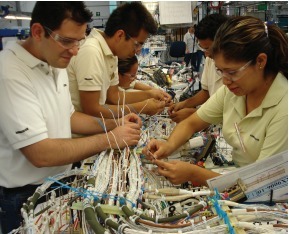Oct 19 2013
A New Approach to Materials Handling in Warehouses
In a discussion in the TPS + 1 SENSEI group on LinkedIn, Casey Ng drew my attention to a materials handling approach from Kiva Systems, a company started up in Boston in 2003 by engineer/MBA Mick Mountz with funding from Bain Capital, that is now a wholly-owned subsidiary of Amazon. The following is a promotional video from Youtube:
The system shown in the video is clever, and can certainly be useful in fulfilling Amazon orders or in kit picking for assembly, but it is also obviously not a panacea. It only supports a single-level of racks, and boxes or bins that can be lifted by people. If you wanted to use the overhead space for storage, you might combine it with a classical automatic storage and retrieval system, which would move the portable racks to and from from upper levels for further handling on the ground by the Kiva pods.
Bringing materials to an operator at a fixed location rather than have the operator travel to do the picking is what is also attempted by carousels, but carousels require the operator to wait up to a half-turn for the right slot to be presented, and are limited in the number of items they can carry.
 As shown in the video, while the concept is innovative in terms of storage and retrieval, it does not stretch hardware technology. As we see on the video, we see the operator who loads boxes onto racks for putaway use devices that look like the ones used in restaurants like The Cheesecake Factory or the Fish Market to notify waiting customers that their tables are ready. The pods look like giant Roombas, but move in a more restricted manner. According to Mick Mountz, the pods just move around the grid of small squares marked on the floor with optical guidance and a simple form of “after-you” system to avoid collisions. On the video, auto-ID seems to be based on plain old barcodes. There is no mention of RFID or even QR-codes. The actual transfer of boxes is manual, with a form of pick-to-light guidance. While less visible, the software that coordinates all the moving parts is clearly at the core of this system.
As shown in the video, while the concept is innovative in terms of storage and retrieval, it does not stretch hardware technology. As we see on the video, we see the operator who loads boxes onto racks for putaway use devices that look like the ones used in restaurants like The Cheesecake Factory or the Fish Market to notify waiting customers that their tables are ready. The pods look like giant Roombas, but move in a more restricted manner. According to Mick Mountz, the pods just move around the grid of small squares marked on the floor with optical guidance and a simple form of “after-you” system to avoid collisions. On the video, auto-ID seems to be based on plain old barcodes. There is no mention of RFID or even QR-codes. The actual transfer of boxes is manual, with a form of pick-to-light guidance. While less visible, the software that coordinates all the moving parts is clearly at the core of this system.
I learned of Kiva’s existence this morning, and have no relationship with this company.










Oct 21 2013
Bombardier receives award from the AME | ept
See on Scoop.it – lean manufacturing
 “Recognizing organizations that are implementing lean manufacturing and management processes is one of the highlights of our conference,” says Paul Kuchuris, AME […]
“Recognizing organizations that are implementing lean manufacturing and management processes is one of the highlights of our conference,” says Paul Kuchuris, AME […]
When evaluating Bombardier’s Toronto site, the AME assessment team was impressed by the use of improvement tools, especially with regards to the organization’s approach to Standardized Problem Solving and an empowerment system called Xcell. Combined, these processes drive continuous improvement and engagement by the workforce down to the shop-floor level. Equally impressive to the team was the level of accountability at Bombardier’s Toronto Site and an understanding that the entire organization must change to meet evolving demands and new visions.”
According to this article, the AME recognized Bombardier as having implemented Lean Manufacturing on the basis of having Standardized Problem Solving and an individual suggestion system called Xcell.
Is that it? I have to assume that Bombardier has done a few other things to improve quality, productivity, delivery, safety, and morale, including perhaps designing production lines for flow, reducing setup times, implementing a pull system with heijunka, mistake-proofing manual operations, setting up work teams with job rotations, …
What did they actually do and how well did it work? The article does not say.
See on www.ept.ca
Share this:
Like this:
By Michel Baudin • Press clippings 0 • Tags: AME, Awards